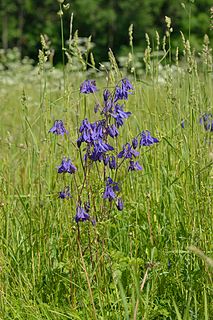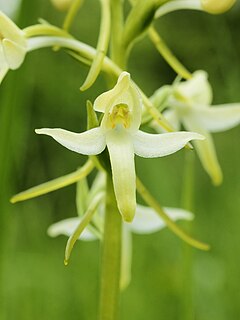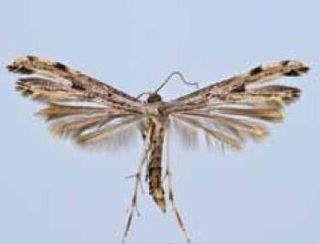
Bidens is a genus of flowering plants in the aster family, Asteraceae. The common names beggarticks, black jack, burr marigolds, cobbler's pegs, Spanish needles, stickseeds, tickseeds and tickseed sunflowers refer to the fruits of the plants, most of which are bristly and barbed, with two sharp pappi at the end. The generic name refers to the same character; Bidens comes from the Latin bis ("two") and dens ("tooth").

Aquilegia vulgaris is a species of columbine native to Europe with common names that include: European columbine, common columbine, granny's nightcap, and granny's bonnet. It is a flowering herbaceous perennial plant growing to 1.2 m tall, with branched, thinly hairy stems. The leaves are biternate; each leaf has three groups of three leaflets. The flowers, in various shades of purple, blue, pink and white, are pendent or horizontal with hooked spurs, and appear in early summer.

Banksia nivea, commonly known as honeypot dryandra, is a species of rounded shrub that is endemic to Western Australia. The Noongar peoples know the plant as bulgalla. It has linear, pinnatipartite leaves with triangular lobes, heads of cream-coloured and orange or red flowers and glabrous, egg-shaped follicles.

The genus Platanthera belongs to the subfamily Orchidoideae of the family Orchidaceae, and comprises about 150 species of orchids. The members of this genus, known as the butterfly orchids or fringed orchids, were previously included in the genus Orchis, which is a close relative. They are distributed throughout the temperate regions of the Northern Hemisphere. They are terrestrial and have tubercules.

Lipochaeta, common name nehe, is a genus of flowering plants in the family Asteraceae that is endemic to Hawaii.

Melanthera, squarestem, is a genus of flowering plants in the family Asteraceae, native to North and South America, as well as Africa, Asia and Oceania, including Hawaiʻi.

Veronica nivea, the milfoil speedwell or snow speedwell, is a flowering plant species of the family Plantaginaceae, endemic to south-eastern Australia. It is sometimes included in the genus Parahebe or Derwentia.

Melanthera fauriei, known by the common name Olokele Canyon nehe, is a rare species of flowering plant in the aster family.
Melanthera kamolensis, known by the common name Maui nehe, is a rare species of flowering plant in the family Asteraceae.

Melanthera micrantha, known by the common name Kauai nehe, is a rare species of flowering plant in the family Asteraceae.

Melanthera tenuifolia is a rare species of flowering plant in the family Asteraceae known by the common names Waianae Range nehe and slender-leaf nehe.

Adaina ambrosiae is a moth of the family Pterophoridae. It is found in North America from California east to Florida and north to Ontario. It is also known from Bermuda, Costa Rica, Jamaica, Puerto Rico and the Virgin Islands.

Hymenia perspectalis, the spotted beet webworm moth, is a species of moth of the family Crambidae. It is found in various parts of the world, including North America, where it is found from Maine to Florida, west to Texas and north to Michigan and Ontario. It is also found in Belize, Hong Kong, Jamaica, Australia (Queensland), the Comoros, Equatorial Guinea, Réunion and South Africa. The species was described by Jacob Hübner in 1796.

Argyrochosma nivea is an Andean fern species in the genus Argyrochosma.

Melanthera biflora, also known as sea daisy, beach daisy and sea ox-eye, is a species of flowering plant in the family Asteraceae. It is a scandent, rough-looking and fast-growing plant with a wide distribution.

Digitaria ciliaris is a species of grass known by the common names southern crabgrass, tropical finger-grass, tropical crabgrass or summer grass.
Helcystogramma melantherella is a moth in the family Gelechiidae. It was described by August Busck in 1900. It is found in North America, where it has been recorded from North Carolina south to Florida and west to Texas and Arkansas.
Petrophile nivea is a species of flowering plant in the family Proteaceae and is endemic to southwestern Western Australia. It is a small shrub with crowded cylindrical, sharply-pointed leaves and more or less spherical heads of hairy white or cream-coloured flowers on the ends of branchlets.

Geissorhiza melanthera is a small perennial plant of 14–18 cm high that is assigned to the Iridaceae. It survives the dry southern summer through storage of its resources in a corm. The stem carries two or three erect, sticky leaves of up to 18 cm (7 in) long, H-shaped in cross-section. This species blooms with six to twelve bilaterally symmetrical flowers, in a spike. Sometimes the spike has one side branch with fewer flowers. Each flower has six pale beige perianth lobes, a purple-red ring around a purple red tube and three blackish stamens. Each flower is subtended by two 1¼–2¼ cm long green bracts. This species was found flowering from the end of September till mid October. It is an endemic of the western slopes of the Piketberg mountains in the Western Cape province of South Africa.

















